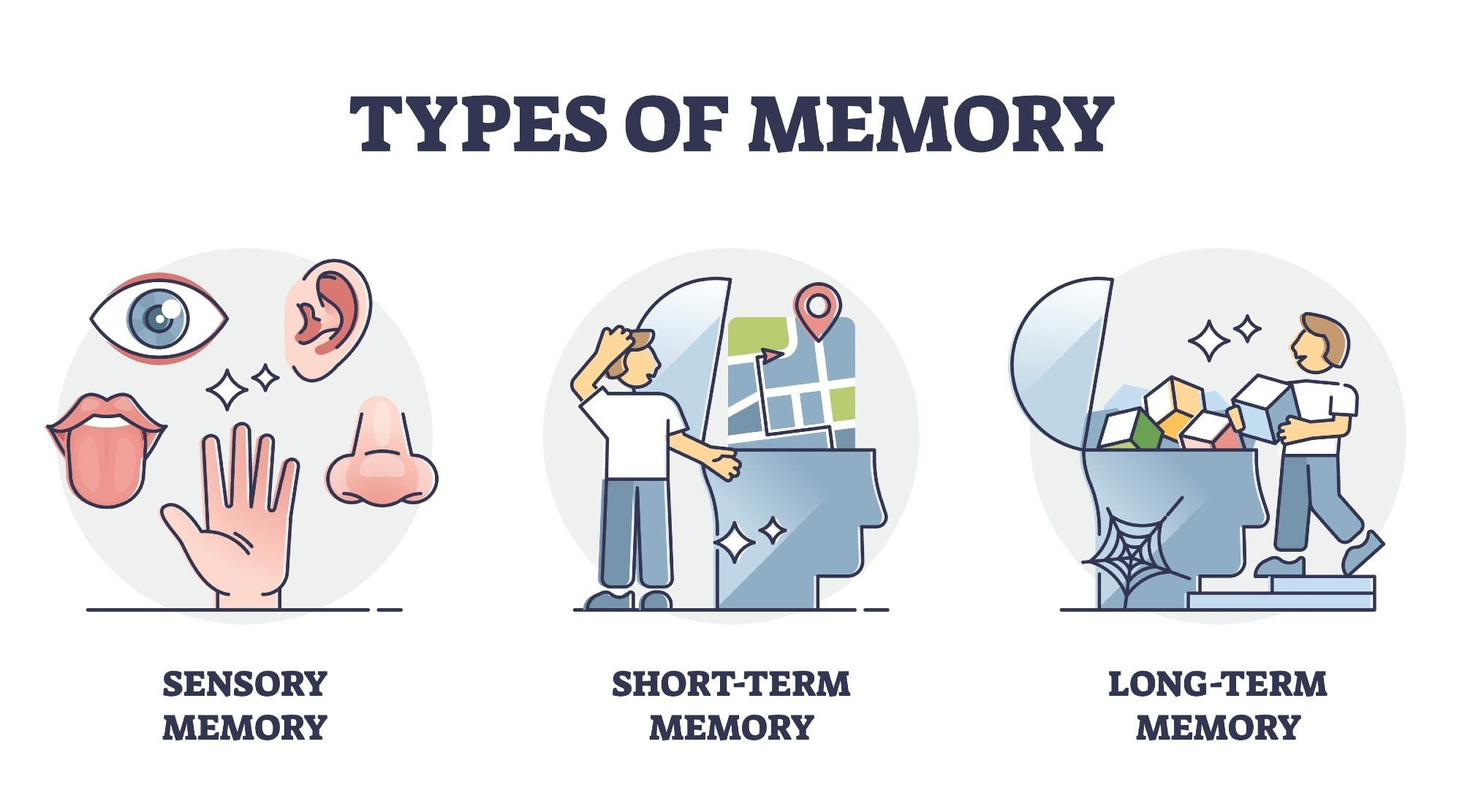
Introduction
Multi-Store Memory Model
Sensory Memory
Short-Term Memory
Long Term Memory
Working Memory Model
Central Executive
Articulatory-Phonological Loop
Visuo-Spatial Sketchpad
References
Memory has been studied since the birth of cognitive science. While there are several explanations of memory, there is a broad consensus that it functions similarly to computerized processes. It sorts information, processing it effectively along the way.
As Psychology mostly lacks paradigms, understanding how memory works varies somewhat depending on the relevant theory or school of thought. Some common theories include the Multi-Store Memory Model and the Working Memory Model.

Image Credit: Kittyfly/Shutterstock.com
Multi-Store Memory Model
One of the earliest models of memory is the Multi-Store Memory Model. This model effectively views memory as being moved between the Sensory Register, the Short-Term Store, and the Long-Term Store.
Each store has its own set of characteristics, including the encoding of memory, the store’s capacity, and the time the information is held. The stores are joined together using different processes.
 How are 'Strong' Memories Formed?
How are 'Strong' Memories Formed?The Multi-Store Memory Model provides a fairly simplistic perspective of how memory works. For example, the theory doesn’t provide a depth of information about each individual memory store. However, as the theory is relatively old, this is perhaps to be expected. Furthermore, the theory provided the basis for a great deal of further research.
Sensory Memory
The first store in the Multi-Store Memory Model is the Sensory Register (S.R.). This handles sensory inputs from the environment, such as sight, sound, smell, touch, and taste.
All information that becomes memory enters this store first. This is because any external stimuli that are cognitively processed are engaged with through a sensory modality. Consequently, all information in this store uses sensory encoding.
The S.R. has the shortest duration of all memory stores and can hold information for approximately 250 milliseconds. On the other hand, its capacity may be immensely large, meaning that a large amount of information can be held in the store simultaneously. The precise capacity of the S.R. remains unknown.
Short-Term Memory
The next store in the Multi-Store Memory Model is the Short-Term Store (STS). This is the section of the model that handles short-term memory. When information is successfully transferred from the S.R. into the STS, it is encoded acoustically. This means that the information held in short-term memory is present as sound.
Information can be held in this store for approximately twenty seconds. This information is held there using a ‘rehearsal loop’, which repeats the information to hold it in that store.
The capacity of the STS is complicated. It falls between five and nine items depending on how the information is “chunked” together, with the figure being known as ‘7+-2’. Chunking is information strung together to make it manageable for the STS.
Long Term Memory
The final store in the Multi-Store Memory Model is the Long-Term Store (LTS), where long-term memory is held. Infinite information can be transferred from the STS to the LTS and held indefinitely.
When memories are recalled, memory isn’t recalled directly from the LTS. Instead, it is retrieved from the LTS into the STS. From there, the information is held in the rehearsal loop for as long as the information is required.
Long-term memory is encoded semantically, although it may also be visually or acoustically. For the memory to be encoded semantically, it means that the information has a meaning associated with it.
This is achieved through ‘elaborative rehearsal,’ a process leading to the information being meaningfully allocated. This occurs when the information in the STS is transferred to the LTS.

Image Credit: VectorMine/Shutterstock.com
Working Memory Model
The Working Memory Model provides a more detailed understanding of short-term memory. The model was proposed in 1974, although it was also updated numerous times since then.
The Working Memory Model splits short-term memory into three stores: the Central Executive, the Articulatory-Phonological Loop, and the visuo-spatial Sketchpad. Subsequently, another figure was added to the model, acting as a point of communication between short-term and long-term memory.
This is known as the Episodic Buffer, and less is understood in the literature.
Central Executive
The Central Executive sorts information into the correct store. It achieves this by regulating cognitive processes, such as guiding focus. It also helps to coordinate short-term and long-term memory, along with the Episodic Buffer.
The original understanding of the Central Executive was that it sat in the center of the memory, passing information to the correct stores. As of 2000, research suggested that there may be separate Central Executives for the different parts of short-term memory. However, the literature remains divided.
Articulatory-Phonological Loop
The Articulatory-Phonological Loop (APL) is the model section most similar to the preceding Multi-Store Memory Model. This handles auditory information on a short-term basis.
The APL is made up of two subsections known as the Articulatory Rehearsal Processes (ARP) and the Phonological Loop (P.L.).
The ARP is often referred to as the “inner voice.” This means internal monologues and linguistic information, such as speech, are processed here. This includes written language converted to acoustic information while reading or writing.
The P.L. is part of the APL that holds or stores the information the ARP converts. Because of the way it holds auditory information, it is often referred to as the “inner ear.”
Visuo-Spatial Sketchpad
The visuo-spatial sketchpad (VSSP) is part of the short-term memory that handles non-linguistic visual information and spatial data. This is effectively the “inner eye.”
An elaborated form of the VSSP was proposed in 1995, consisting of the Inner Scribe (I.S.) and the Visual Cache (V.C.). The I.S. handles spatial information, such as movement, while the V.C. stores visual information, like form or color.
References:
- Atkinson, R.C. and Shiffrin, R.M. (1968). Human memory: A proposed system and its control processes. In Spence, K.W.; Spence, J.T. (eds.). The psychology of learning and motivation. Vol. 2. New York: Academic Press. pp. 89–195.
- Baddeley, A. D., and Hitch, G. (1974). Working memory. In Psychology of learning and motivation, 8, 47-89.
- Baddeley, A. (2000). The episodic buffer: a new component of working memory?. Trends in cognitive sciences, 4(11), 417-423.
- Chai, W. J., et al. (2018). Working memory from the psychological and neurosciences perspectives: a review. Frontiers in psychology, 9, 401.
- Miyake, A., et al. (2000). The unity and diversity of executive functions and their contributions to complex “frontal lobe” tasks: A latent variable analysis. Cognitive psychology, 41(1), 49-100.
- Logie, R. H. (1995). Visuo-Spatial Working Memory. Hove: Lawrence Erlbaum Associates Ltd.
- Thalmann, M. et al. (2019). How does chunking help working memory?. Journal of Experimental Psychology: Learning, Memory, and Cognition, 45(1), 37.
Last Updated: May 10, 2023
Source: Read Full Article